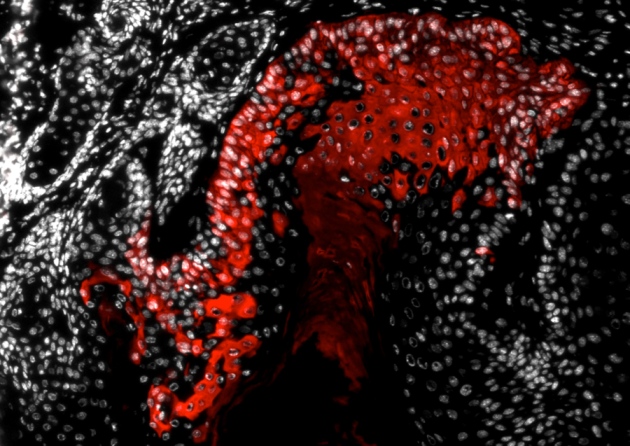Why cancer treatment fails ? – This question is raised by family members of cancer patients around the world and Doctors and Researchers were unable to answer. Many recent studies have shown that one of the main reason for failures in cancer treatment could be lack of precision in targeting the right cells. But what are right cells ?. This was not difficult to answer as most researchers believed that they are the cancer stem cells but were difficult to identify as there were no proper methods available to identify them. If these cells can be identified and distinguished from other cells, treatment strategies could be more focused.
Four recent studies found a way to identify the cancer stem cells. If this is found in other cancers also, then it will change totally the parameters used for evaluating success of chemotherapy and method of treating cancers.
Finding of study -1: [from our earlier post]
Breast cancers are thought to be organized hierarchically with a small number of breast cancer stem cells (BCSCs) able to regrow a tumor while their progeny lack this ability. Recently, several groups reported enrichment for BCSCs when breast cancers were subjected to classic anticancer treatment. However, the underlying mechanisms leading to this enrichment are incompletely understood.
Using non-BCSCs sorted from patient samples, we found that ionizing radiation reprogrammed differentiated breast cancer cells into induced BCSCs (iBCSCs). iBCSCs showed increased mammosphere formation, increased tumorigenicity, and expressed the same stemness-related genes as BCSCs from nonirradiated samples. Reprogramming occurred in a polyploid subpopulation of cells, coincided with re-expression of the transcription factors Oct4, sex determining region Y-box 2, Nanog, and Klf4, and could be partially prevented by Notch inhibition. We conclude that radiation may induce a BCSC phenotype in differentiated breast cancer cells and that this mechanism contributes to increased BCSC numbers seen after classic anticancer treatment.
Findings of Study-2:
This studey tested a genetic marker that labels healthy adult neural stem cells (but not their differentiated descendents) on tumors and checked weather the marker also labels cancer stem cells in brain cancer. When they did so, they found that all tumours contained at least a few labelled cells — presumably stem cells. Tumours also contained many unlabelled cells2. The unlabelled cells could be killed with standard chemotherapy, but the tumours quickly returned. Further experiments showed that the unlabelled cells originated from labelled predecessors. When chemotherapy was paired with a genetic trick to suppress the labelled cells the tumours shrank back into “residual vestiges” that did not resemble glioblastoma.

[Stem cells stained red]
Findings of study-3
This study followed their earlier results which showed that a genetic marker that labels healthy gut stem cells also labels stem cells in benign intestinal tumours, which are precursors of cancer. In the present study a transgenic mice carrying a gene for a drug-inducible marker was used. This marker , when activated, causes labelled cells to make molecules that fluoresce one of four colours. This experiment yielded single-colour tumours consisting of several cell types, suggesting that each tumour arose from a single stem cell.
Finding of study -4:
This study was on skin cancer cells where individual cancer cells were labeled without targeting stemm cells specifically. The cells showed two distinct patterns of division: they either produced a handful of cells before petering out, or went on to produce many cells. Once again, the results pointed to a distinct subset of cells as the engine of tumour growth. What’s more, as tumours became more aggressive, they were more likely to produce new stem cells — which can divide indefinitely — and less likely to produce differentiated cells, which can divide only a limited number of times.
So, what is the future ?. These studies show that there are special cells called cancer stem cells which are responsible for tumor growth and not killing them specifically could be the reason for failure in cancer treatment using chemotherapy. We can expect targeted methods to kill them in the near future. Wish better success rate in cancer treatment soon.
Driessens, G., Beck, B., Caauwe, A., Simons, B. D. & Blanpain, C.
Defining the mode of tumour growth by clonal analysis Nature http://dx.doi.org/10.1038/nature11344 (2012).
Chann Lagadec, Erina Vlashi, Lorenza Della Donna, Carmen Dekmezian, Frank Pajonk Radiation-Induced Reprogramming of Breast Cancer Cells STEM CELLS Volume 30, Issue 5, pages 833–844, May 2012 (2012)
Chen, J. et al. A restricted cell population propagates glioblastoma growth after chemotherapy
Nature http://dx.doi.org/10.1038/nature11287 (2012).
Schepers, A. G. et al. Lineage Tracing Reveals Lgr5+ Stem Cell Activity in Mouse Intestinal Adenomas Sciencehttp://dx.doi.org/10.1126/science.1224676 (2012).


0 comments:
Post a Comment